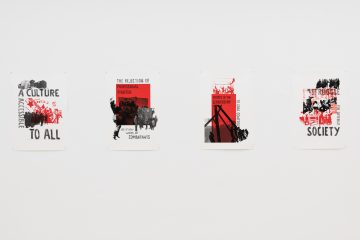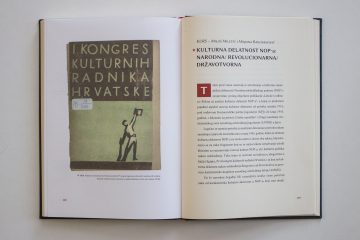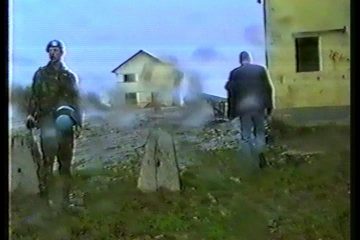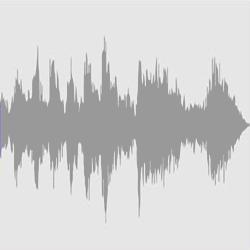BÜCHS’N’RADIO in February
Büchsenhausen Start Up Lectures 2016-17:
Takes on the Crip Magazine + Sonic Chemicals—Chromatic Pharmaceutics
A broadcast in collaboration with Eva EGERMANN and Kerstin SCHROEDINGER
——————————-
In 2016-17, the Fellowship Program for Art and Theory at Künstlerhaus Büchsenhausen fokuses on projects concerned with physical deviance, educational spirits, apparently obsolete image production processes, and former geopolitics. In the context of the Start Up Lectures 2016-17 on 21 October 2016, the new fellows Eva Egermann, Stefan Hayn, Kerstin Schroedinger, and Vladislav Shapovalov presented their work and their plans for the coming months.
Eva EGERMANN is an artist living in Vienna. In her research-based practice, Egermann works with oppositional practices, assimilations, social movements and pop cultures linked to deviance, abnormality, illness and disability. She works with examples from various times and places, which trigger resistance, irritation or contradiction within aesthetic representations of the undamaged. A huge range of materials can be found in her artistic projects – restaged, revised (e.g. in the form of a newspaper) – or during band practice.
The second issue of the Crip Magazine – a self-published magazine and a collection of materials on crip themes, art and cultural production, and representations opposing the conditions of normality/abnormality – forms the starting point for Egermann’s work in Künstlerhaus Büchsenhausen. In the course of the fellowship, the editorial office will be realized in many different ways in varying scenarios.
Kerstin SCHROEDINGER is an artist working with video, sound and text. Her historiographic practice questions the means of film production, historical continuities and ideological certainties of representation. Her films and curatorial practice are often collaborative.
Continuing her research into the historical and material conditions of analogue film, Schroedinger’s project in Büchsenhausen starts out with the history of the chemicals industry and in particular the pharmaceuticals industry at the beginning of the 20th century, which – like the photographic industry – had its origins in the syntheticizing of colorants. The project comprises material research exploring formal, social, economic and political questions of image production by means of experimental, performance-based image production.
The deliberations and outcomes of the research will lead to a film project with the working title DNCB vs Broccoli, which is being developed in cooperation with artist and filmmaker Oliver Husain. In Büchsenhausen Schroedinger and Husain would like to conceive a presentation format for this project – in the form of workshops, lab set-ups, lectures and installations.
BÜCHS’N’RADIO im Februar
Büchsenhausen Start Up Lectures 2016/17:
Takes on the Crip Magazine + Sonic Chemicals—Chromatic Pharmaceutics
Eine Sendung in Zusammenarbeit mit Eva EGERMANN und Kerstin SCHROEDINGER
——————————-
Das Fellowship-Programm für Kunst und Theorie stellt im Jahr 2016/17 Arbeitsvorhaben in den Mittelpunkt, die sich mit körperlichen Devianzen, Bildungsgeistern, scheinbar obsoleten Bildproduktionsverfahren und ehemaligen Geopolitiken befassen.
Im Rahmen der Start Up Lectures am 21. Oktober 2016 stellten die neuen Fellows Eva Egermann, Stefan Hayn, Kerstin Schroedinger und Vladislav Shapovalov sich und ihr jeweiliges Arbeitsvorhaben für die kommenden Monate vor.
Eva EGERMANN ist Künstlerin und lebt in Wien. In ihrer Recherche-basierten Praxis beschäftigt sie sich mit widerständigen Praktiken, Aneignungen, Sozialen Bewegungen und Popkulturen, die mit Devianz, Abnorm, Krankheit und Behinderung zu tun haben. Sie arbeitet mit Beispielen aus verschiedenen Zeiten und Orten, die Aufbegehren, Irritation oder Widerspruch innerhalb ästhetischer Repräsentationen von Unbeschädigtheit auslösen. Verschiedenste Materialien finden sich in ihren künstlerischen Projekten wieder, reinszeniert, überarbeitet (z.B. in Form einer Zeitung) oder während einer Bandprobe.
Die zweite Ausgabe des Crip Magazine – einer selbstpublizierten Sammlung von Materialien zu Crip-themen, Kunst- und Kulturproduktion und Repräsentationen im Widerspruch zu Norm/Abnorm Verhältnissen im Magazinformat – bildet den Ausgangspunkt für Egermanns Arbeit im Künstlerhaus Büchsenhausen. Im Laufe des Fellowships realisiert sich die Redaktion auf verschiedenartige Weise in unterschiedlichen Szenarien.
Kerstin SCHROEDINGER ist Künstlerin und lebt in Zürich. Sie arbeitet mit Video, Ton und Text. Mit einem historiografischen Ansatz hinterfragt sie Produktionsmittel, historische Kontinuitäten und ideologische Gewissheiten der Repräsentation. Bei ihren künstlerischen Arbeiten und kuratorischen Projekten handelt es sich meistens um Kollaborationen.
In Fortführung ihrer Recherchen zu den historischen und materiellen Bedingungen von analogem Film nimmt Schroedingers Vorhaben in Büchsenhausen seinen Ausgangspunkt in der Geschichte der chemischen Industrie und insbesondere der Pharma-Industrie zu Beginn des 20. Jahrhunderts, die ebenso wie die Fotoindustrie ihren Ursprung in der Synthetisierung von Farbstoffen hatte. Das Projekt ist eine Materialrecherche, die sich mit formalen, sozialen, ökonomischen und politischen Fragen der Bildproduktion mittels einer experimentellen, performance-basierten Bildproduktion auseinandersetzt. Schroedinger arbeitet mit Ansätzen, die die Dominanz des Visuellen über die materiellen Aspekte des Filmbildes zu dekonstruieren sucht.
Ergebnisse und Überlegungen der Recherche sollen in ein Filmprojekt unter dem Arbeitstitel DNCB vs Brokkoli, der in Zusammenarbeit mit dem Künstler und Filmemacher Oliver Husain entwickelt wird, einfließen. In Büchsenhausen möchte Schroedinger ein Präsentationsformat für dieses Projekt erarbeiten – in Form von Workshops, Laboranordnungen, Vorträgen und Installationen.













